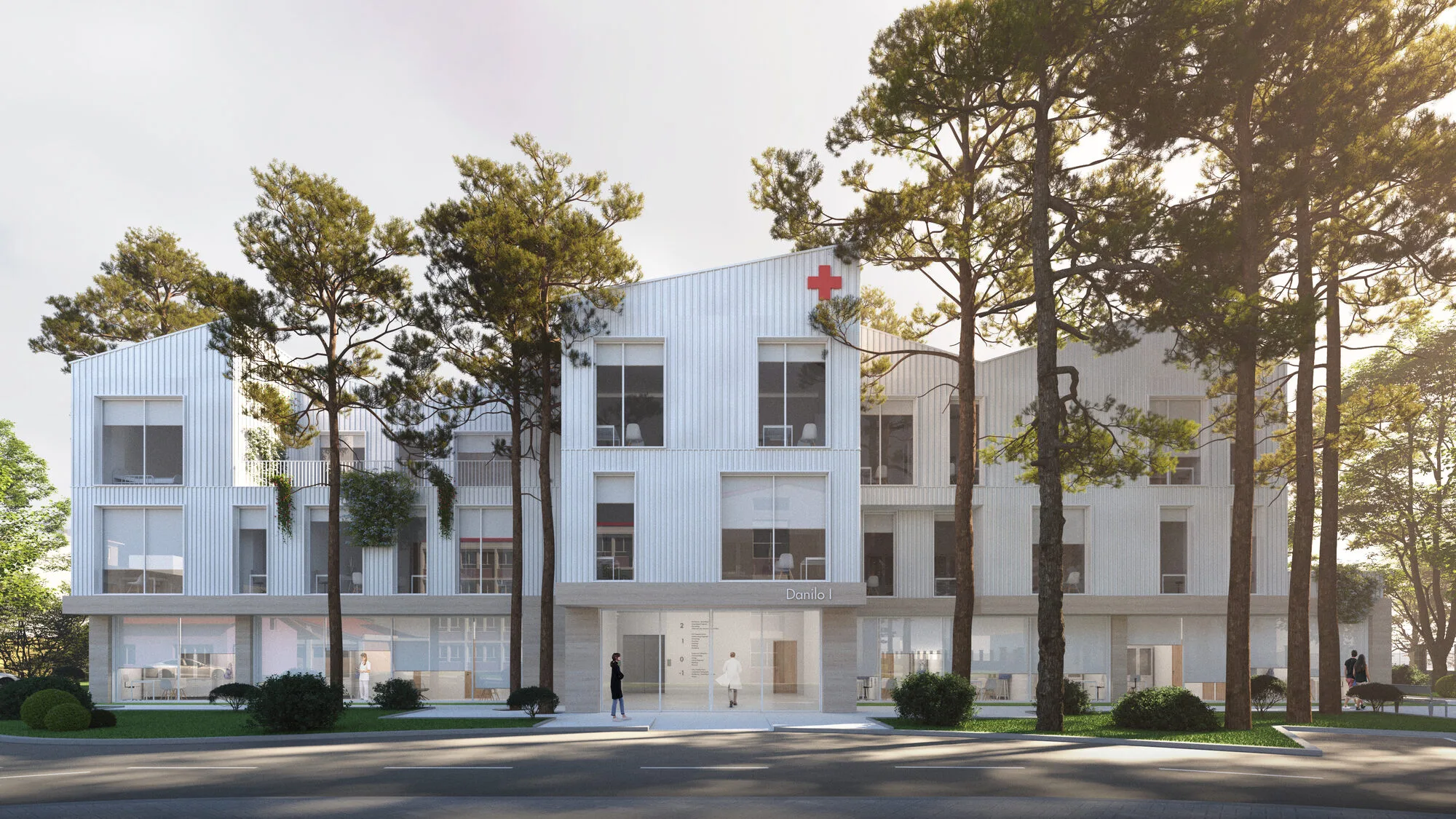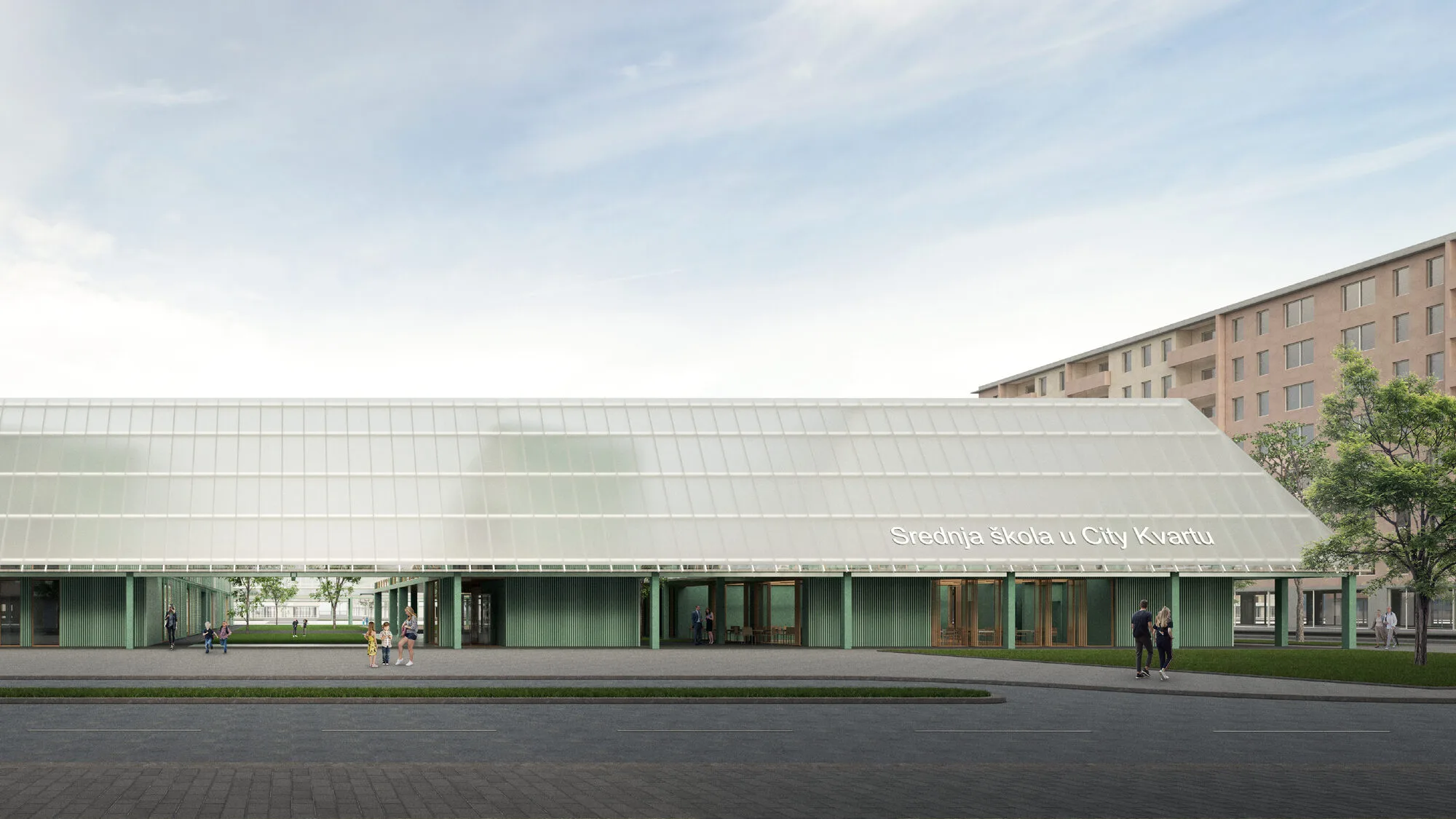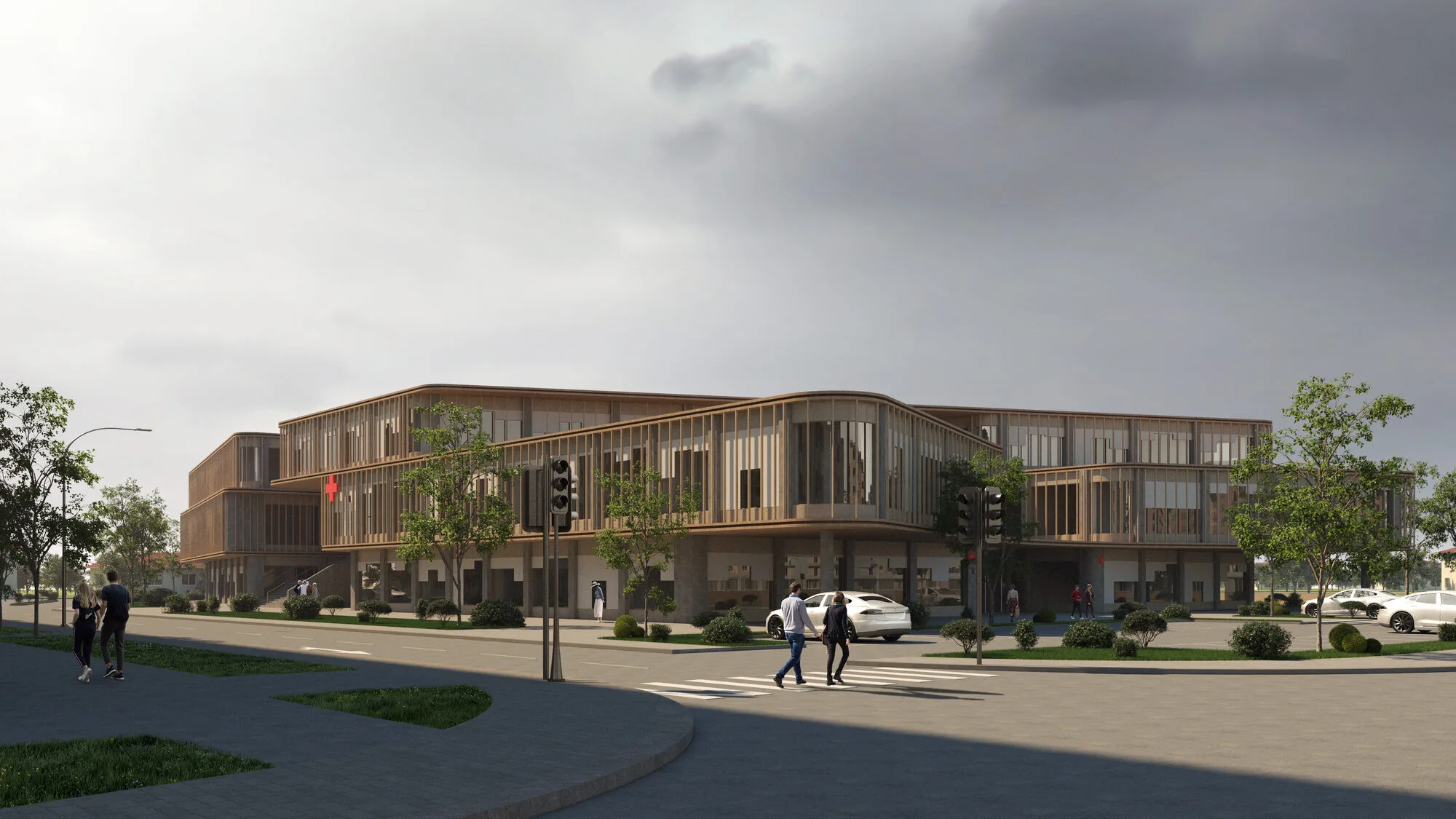
Kvart Polyclinic
Kvart Polyclinic
The design site is situated in the northwestern sector of "Kvart," a city undergoing urban development expansion. This locale and its immediate environs exhibit a distinctive gridded layout and an orthogonal urban planning paradigm. Notably, the vast majority of neighboring architectural ensembles in the nearby vicinity represent segments of predominantly square-shaped complexes, with the objective of harmoniously completing the macro-scale architectural form on an island basis.
This prevailing urban planning tendency, characterized by an expeditious legibility within the urban fabric, concurrently functions as a pivotal reference for prospective architectural endeavors of a supplementary nature. It is noteworthy that the orientation of extensions and the proclivity towards completing the textural and structural fabric within the built environment inherently direct the designer towards a unified outcome.
Kvart Polyclinic
Specifically, the bounding perimeters of architectural islands positioned along the southward extension route possess a quasi-ambivalent and non-centric characteristic. This characteristic has spurred the continuation of such an attribute within the superstructure of prospective edifices or architectural collectives on islands where construction remains incomplete. This situational congruence is also discernible in the conclusion of an architectural design competition for an educational complex. It resonates with the predilections of the competition's jury, underscoring the importance of this direction in contemporary architectural discourse.
The design area experiences a substantial flow of traffic originating from the southeast, predominantly along "Vojvode Maša Đurovića Street." It is safe to assert that the "Design Area" establishes a connection to the city of "Kvart" via this thoroughfare and its parallel northern course. In this context, this street serves as a demarcation where the potential for public interaction could be notably more pronounced compared to the other boundaries.
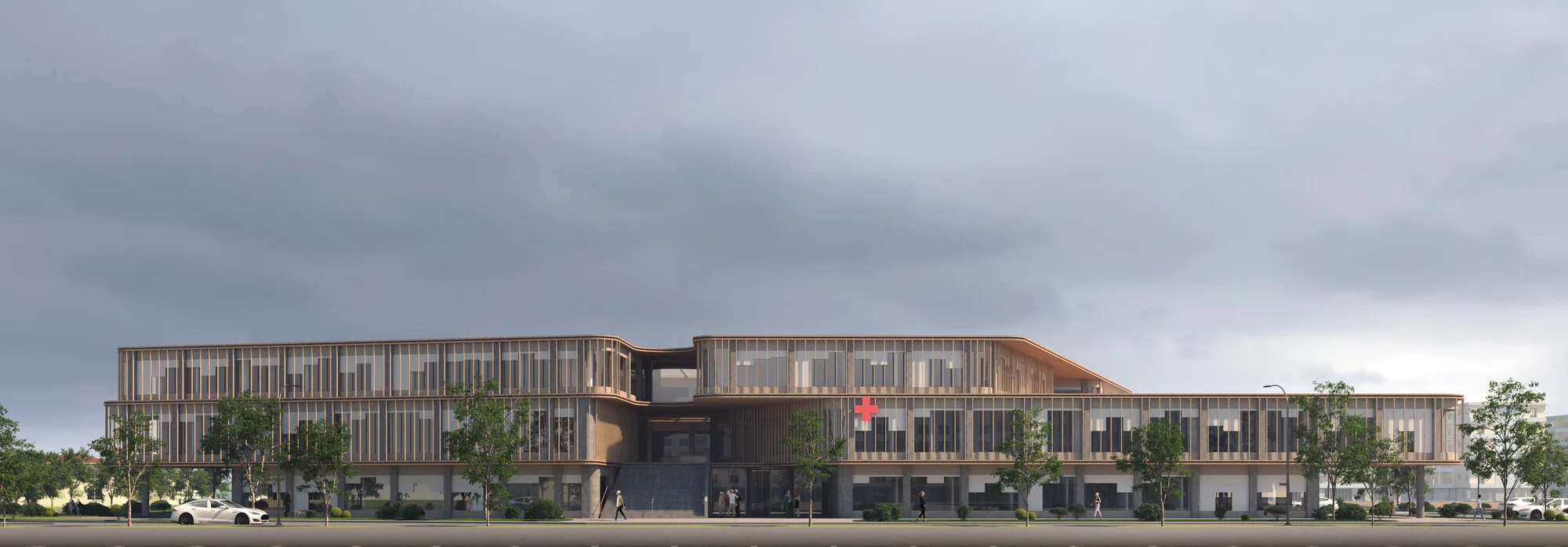
The architectural orientation of adjacent structures during their functional phase frequently reflects an inward-focused way of life. Notably, parking facilities designated to accommodate these building clusters are predominantly situated within courtyard spaces, and, to a certain extent, distributed along the peripheries of building islands. Further analyses and investigations have revealed that the prominent facades of numerous social attraction centers primarily adopt an inward-facing disposition.
Given that the environment concurrently occupies a strategic position along the course of urban development, it provides a clear indication that several upcoming public structures, whether designed or envisaged through competitive processes, are poised to materialize within these vicinities. This anticipation is further substantiated by the legend decisions that outline future functionalities, particularly the "Cultural Center & Shopping Mall," positioned in the immediate eastern vicinity of the design area.
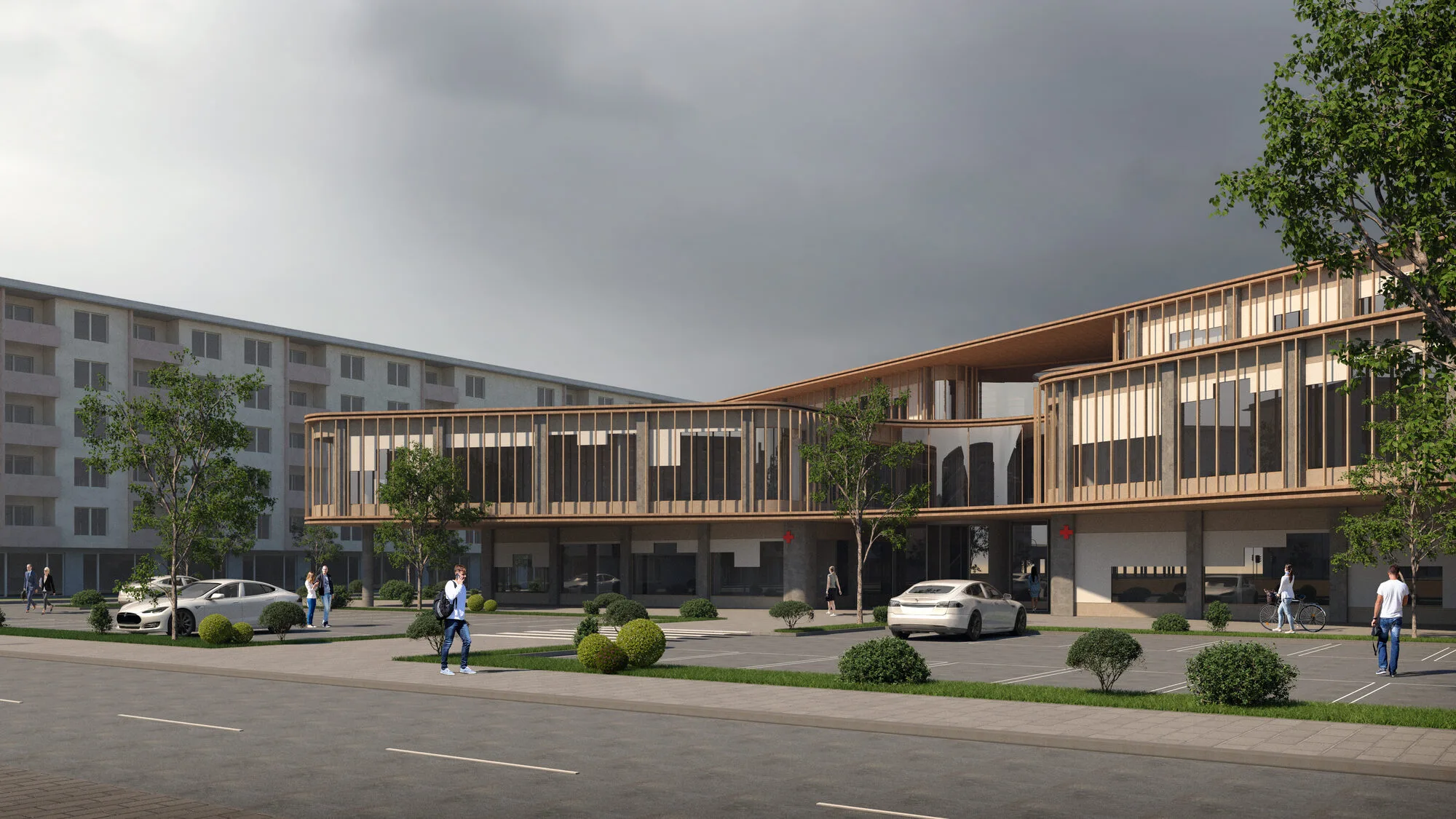
Context
When considering the primary design criteria essential for a healthcare facility, the following key factors must be addressed;
- Immediate Responsiveness: The capacity to deliver prompt responses to urgent situations is paramount.
- Functional Efficiency: The facility should be operationally efficient to cater to the requirements of various departments.
In this context, it is of utmost importance that the architectural design enables the structure to be easily comprehensible from both the interior and exterior perspectives, ensuring accurate guidance for the designated user profile. To ensure continuous user orientation and the establishment of a perceptual feedback network, which can guide users within a feasible range towards potential additional spatial sequences, it is imperative to have a comprehensive spatial arrangement. Therefore, the decision has been made to integrate a unified enclosed gallery (atrium) into the architectural design. This arrangement allows all internal departments and subspaces to be perceptible and comprehensible at a local scale with their respective entry points.
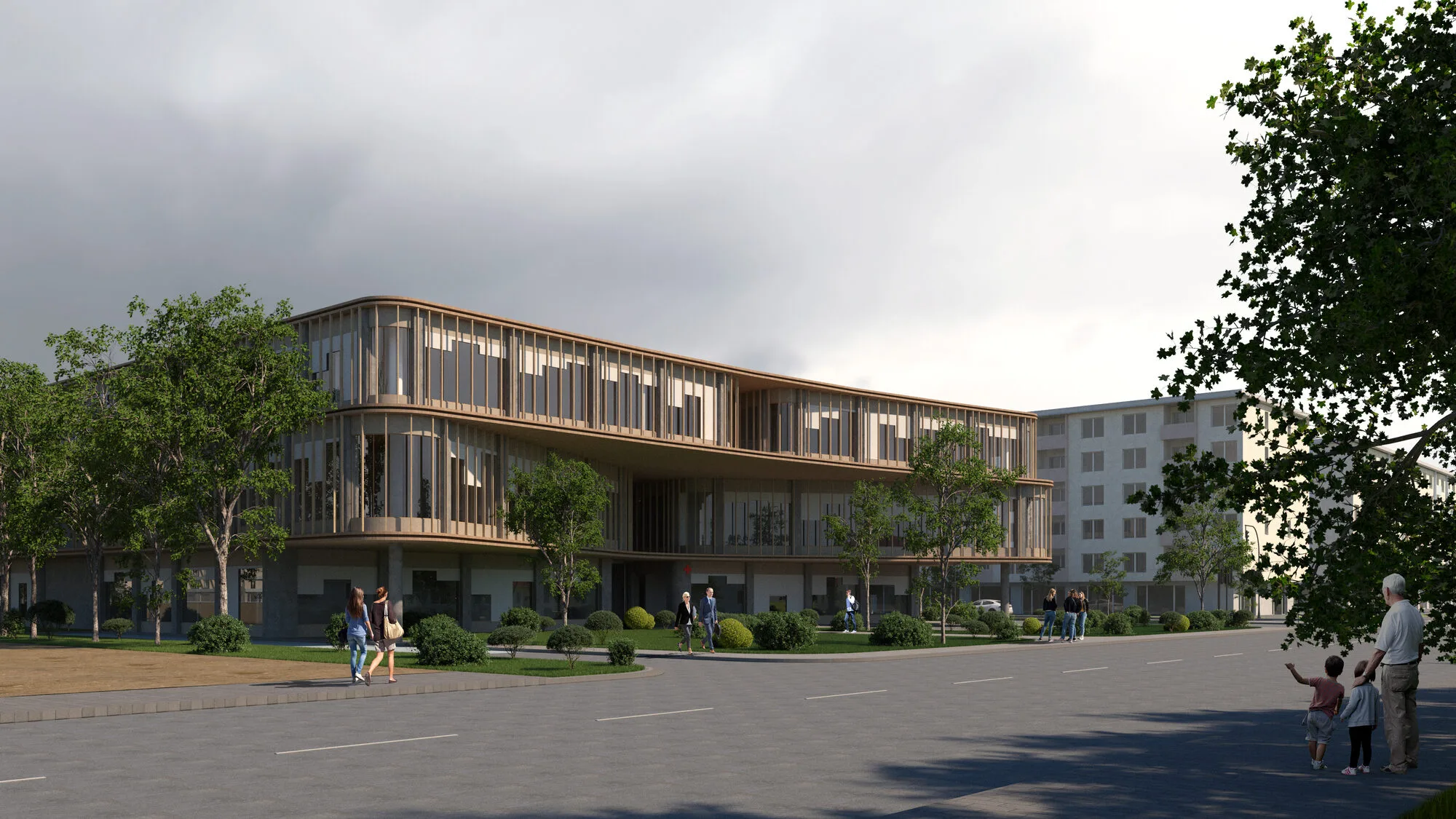
The previously mentioned atrium void serves as the definitive element that bifurcates the architectural composition into two principal wings extending along the north-south axis. It is worth noting that claiming an optimal vista orientation for the right wing of the building cluster might be an overstatement, considering its somewhat inward orientation towards the internal void of the building island. Consequently, within this right-wing building cluster, areas and departments that do not compromise the functionality of enclosed spaces (such as service cores and laboratories) have been strategically situated. Moreover, the architectural program's requirements, as outlined in the competition specifications, underscore the substantial need for spatial components of this nature.
Furthermore, the extensive atrium void, longitudinally aligned within the structure, fulfills the additional role of interconnecting the two primary access axes within the design area. With the objective of diverting potential chaos resulting from ambulance or emergency vehicle traffic away from highly congested urban routes, these entrances have been thoughtfully positioned to the north of the design area. Consequently, this zone, characterized by comparatively lower traffic volume and isolated user-driven movements, ensures the efficient and functional management of emergency situations, thereby enhancing overall effectiveness.
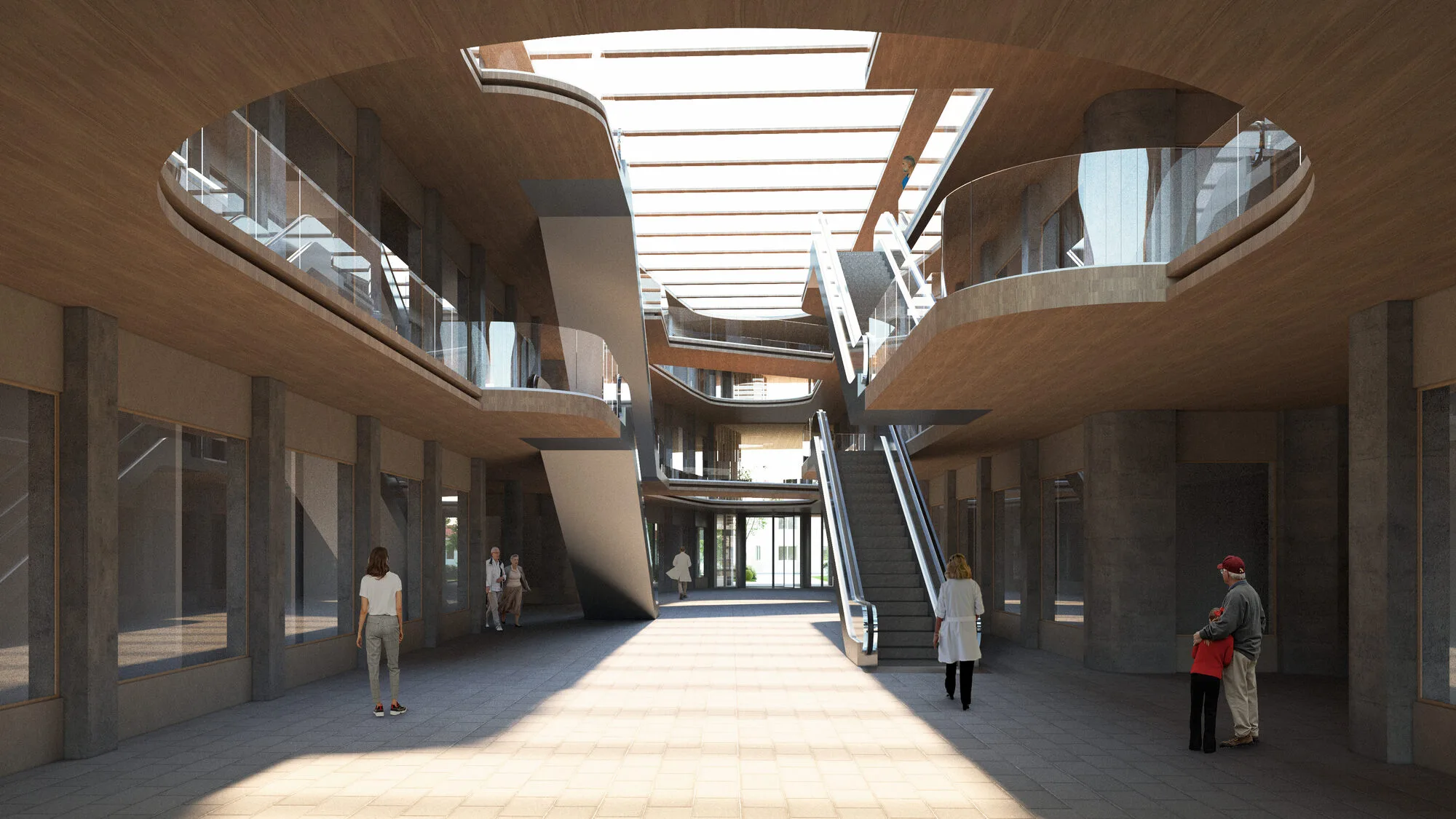
The design area's nearly golden-ratio-approximating rectangular geometry, in conjunction with factors such as the urban context defined in the "Location" section and the rigorous functional requirements of the program, has the potential to generate a design language that borders on monotony and could be deemed problematic. To alleviate this uniformity at the building scale and in its geometry, the building blocks have been subdivided into eastern and western wings, allowing them to extend beyond a length capable of escaping the confines of perceptual networks. These segments have been enriched with intermediate structural supports, cores that truly function as structural elements, and observation terraces. Consequently, the eastern wing now comprises three lower blocks, while the western wing contains two. This approach has also proven advantageous in establishing a hierarchical arrangement for the departments and subspaces during the interpretation of the architectural program.
Despite the expectation that the southern wing of the primary approach axis would prevail in the geometric layout of the design area, the western edge (see Long Side) has been manipulated in the perception of urban users to give the impression of an equally significant primary approach axis. Moreover, the extensive program's requirement for multiple entrances, rather than a single ground-level access point, has transformed the previously mentioned intermediate structural supports into entryways. Additionally, due to spatial constraints on the ground floor, certain departments have been located on the first floor, necessitating public access to this level. In consideration of all these factors, an external staircase structure has been introduced over a module that aligns with the central section of the building's long side to provide external access to the first floor.
In order to enhance the perceptibility and optimize the accessibility of the "Emergency Clinic" department, the block that accommodates this department was internally repositioned with a radial inclination, introducing a heightened perspective to the design. This architectural adaptation significantly influenced the aesthetic identity of the building by introducing curved features and details at each corner, thereby departing from the overall orthogonal configuration.
Additionally, for individuals arriving by vehicular transportation, a designated "Drop-Off" area was strategically integrated to the southern part of the design area in compliance with the architectural requirements. This space is complemented by an open parking facility with a capacity to accommodate around 30 vehicles. This design arrangement allows the single-direction entry and exit ramps of the enclosed parking structure to be efficiently accommodated within the same vicinity.
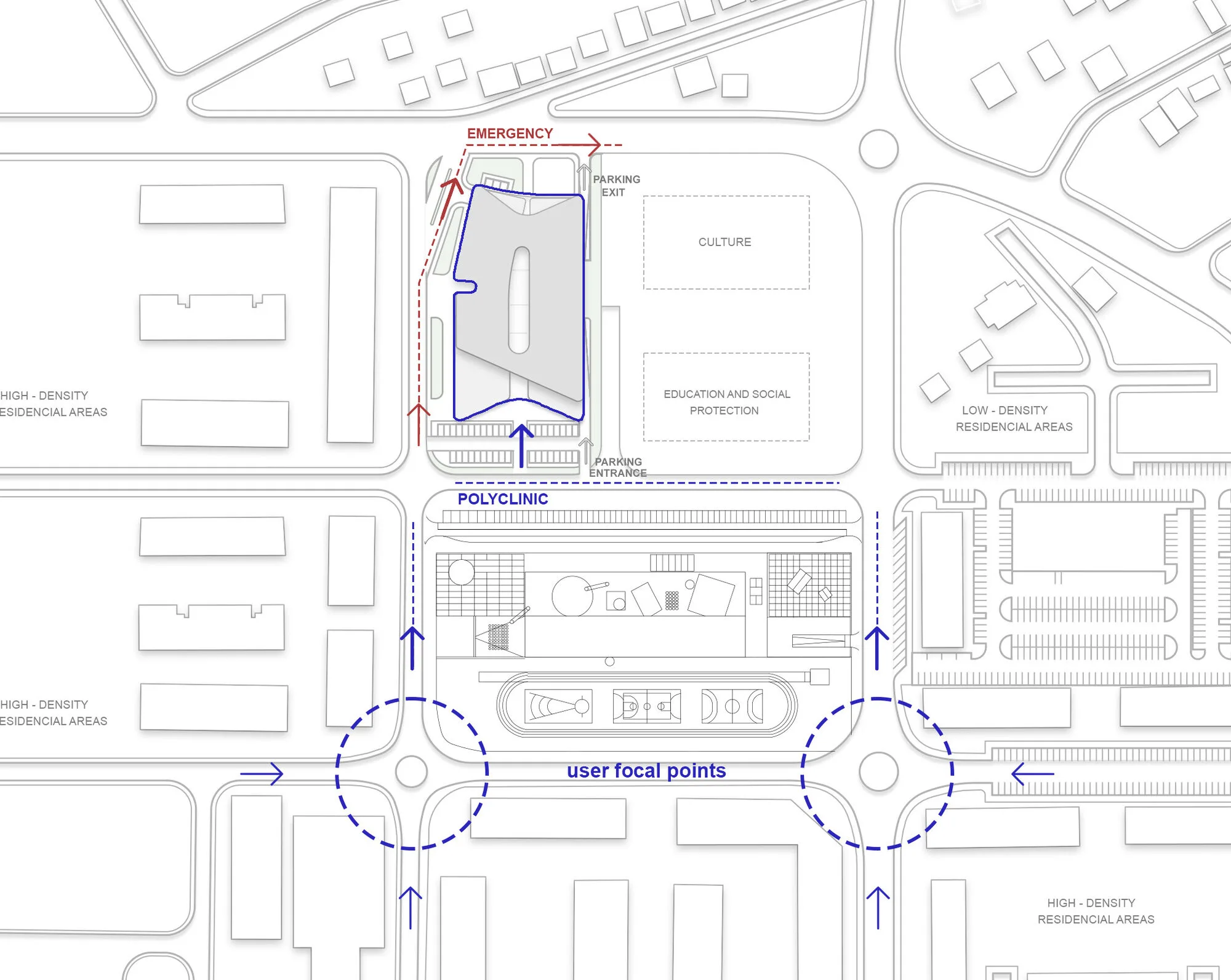
Program
Concerning program interpretation, it is evident that the competition stipulations and empirical requirements of a healthcare facility exerted direct influence on the decisions pertaining to planning and spatial arrangement. Furthermore, areas that were distinctly underscored for ground floor servicing, such as the Emergency Clinic, Obstetrics and Pediatrics, Pharmacy, and others, were situated on their respective floors with dimensions commensurate to their needs. To provide a degree of separation for departments and spaces necessitating isolation, a hierarchical arrangement was established to determine a hierarchy of importance, which was subsequently maintained in the distribution across floors. For instance, departments and spaces like the "Psychological Support Department, Cafeteria, Administrative Office" were affiliated with the second floor.
In terms of regulatory considerations, the constraint of a maximum of three floors and the requirement for intensive floor area utilization prompted the formulation of a design concept where the structure progressively steps back as it ascends, thereby creating terraces and open spaces. This design strategy, devised to mitigate the perception of a densely massed building to the human eye, extended the opportunity for open and semi-open utilization beyond the ground floor, encompassing the upper levels as well.

In order to ensure the optimal functionality of highly utilized floor plans, a system of two interlocking circulation loops was meticulously devised. Specifically, corridors with an approximate width of 3.00 meters were implemented to facilitate the smooth flow of traffic, accommodating wheelchairs, stretchers, and fostering patient-doctor interactions. Furthermore, internal corridors with a width of 1.80 meters were strategically positioned to facilitate seamless interactions within the same user profile, particularly for doctors within their respective functional spaces. In brief, the circulation scheme can be summarized as follows;
- An outer circulation loop with a width of 1.80 meters, designed based on an independent operational principle and tailored for uniform user profiles, encircles the periphery of the facility.
- An intermediate circulation loop, boasting a width of 3.00 meters, is dedicated to activities such as clinical treatments and outpatient diagnoses in the medical practice. This loop serves as the main thoroughfare for vehicles like stretchers and wheelchairs and encourages interactions among different user profiles.
- An internal circulation loop, distinguished by an extended width of 1.80 meters, encompasses the gallery void and connects the eastern and western building blocks through strategically positioned bridge transitions, thereby completing the circulation system.
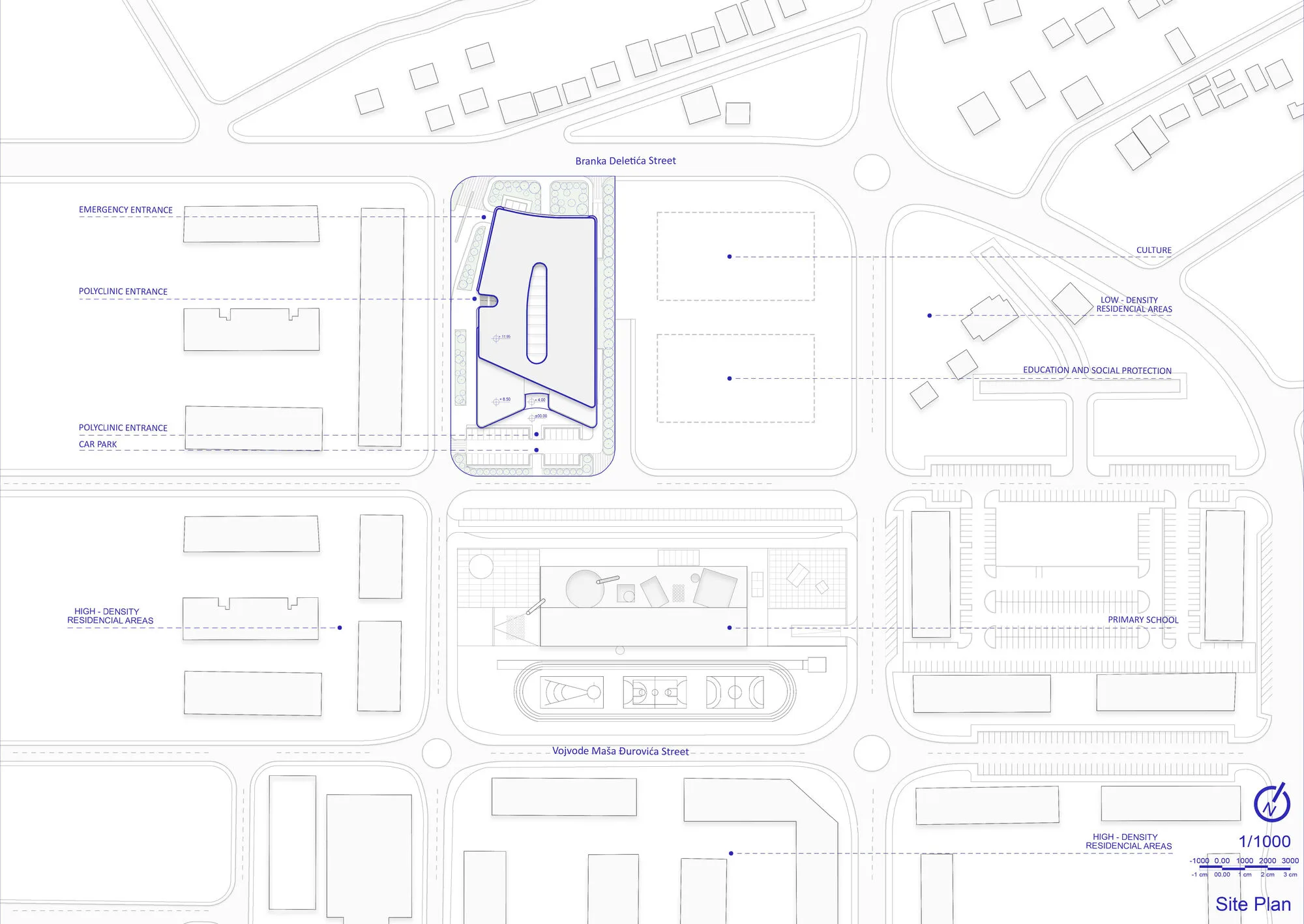
In conjunction with the above, it became evident that certain subspaces within each department exhibited a highly repetitive and almost algorithmic pattern. Notably, spaces such as "Waiting Areas," "(Department-Specific) Restroom Cubicles / Units," "Reception," and "Pantry & Kitchen" were typified within their distinct patterns and replicated across various departments. This approach was also extended to specialized yet recurrently configured spaces within departments, including "Examination Rooms" and "Doctor's Offices."
To streamline operations and enhance user convenience, a traditional core solution was implemented, featuring circulation stairs situated along the gallery's perimeter to offer primary access and time-saving benefits. Additionally, standard staircases, concealed within the core for accessibility during emergencies, were strategically placed to ensure that building occupants could utilize them for similar purposes. Each core was equipped with two high-capacity standard elevators and one considerably larger freight/stretcher/wheelchair elevator.

Material
The structural framework of the building primarily utilizes reinforced concrete, complemented by steel construction for specific extensions and cantilever elements. The selection of reinforced concrete is of paramount significance, primarily to ensure the robust load-bearing capacity of the enclosed parking facility and to address various building physics challenges associated with subterranean levels, capitalizing on its inherent rigidity.
Conversely, as previously mentioned, steel construction is predominantly adopted for the structural extensions on the upper levels of the building. This choice of steel construction not only embraces eco-friendliness, presenting a reduced carbon footprint in comparison to a combination of reinforced concrete materials but also proves economically advantageous while contributing to the overall lightweight nature of the structure. Additionally, it furnishes a broad spectrum of intricate design solutions tailored to the diverse spatial configurations within the building.
The exterior of the building embodies an architectural style achieved through the amalgamation of "Wood - Natural Stone Cladding." The facade's design, characterized by a meticulous attention to modularity, facilitates the seamless integration of any background-originating dividing walls or partitions into the adaptable facade segments. The facade itself is structured into three distinct layers. The rearmost layer consists of a modular frame facade system, the middle layer features vertical wooden sunshade separators, and the foremost layer incorporates foldable and retractable curtain systems designed with an upward-pivoting operational principle. This integrated arrangement defines the architectural approach to the facade, assuring shading possibilities at all times of the day, irrespective of seasonal variations, without the need for protruding eaves.
Within the interior, birch wood panels serve as the primary cladding material. The selection of wood is underpinned by its durability, ease of maintenance, and distinctive attributes, including impact resistance and ergonomic user-friendliness. These characteristics are thoughtfully chosen and particularly relevant for a healthcare facility where user comfort and patient safety take precedence.
